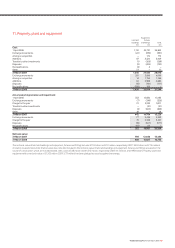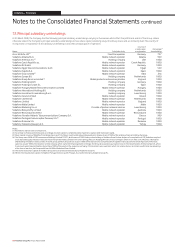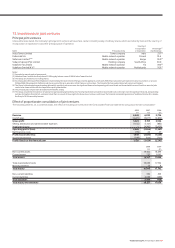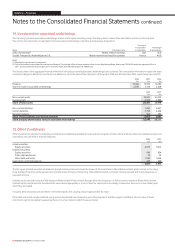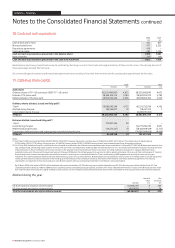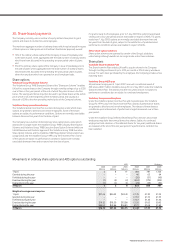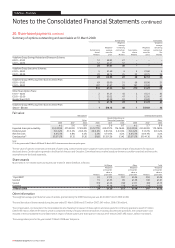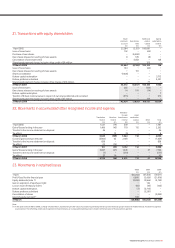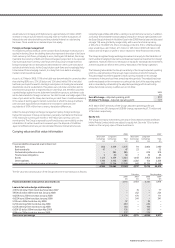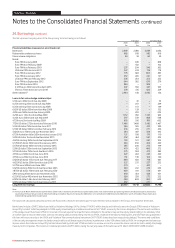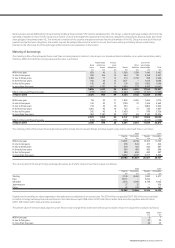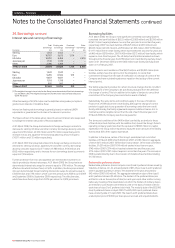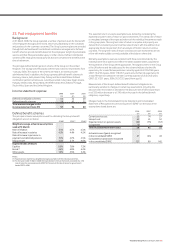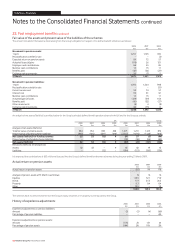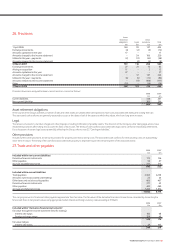Vodafone 2008 Annual Report Download - page 118
Download and view the complete annual report
Please find page 118 of the 2008 Vodafone annual report below. You can navigate through the pages in the report by either clicking on the pages listed below, or by using the keyword search tool below to find specific information within the annual report.
24. Borrowings
Financial risk management
The Group’s treasury function provides a centralised service to the Group
for funding, foreign exchange, interest rate management and counterparty
risk management.
Treasury operations are conducted within a framework of policies and guidelines
authorised and reviewed annually by the Company’s Board, most recently on
25 September 2007. A Treasury Risk Committee, comprising of the Group’s
Chief Financial Officer, Group General Counsel and Company Secretary, Group
Treasurer and Director of Financial Reporting, meets at least annually to review
treasury activities and its members receive management information relating
to treasury activities on a quarterly basis. In accordance with the Group treasury
policy, a quorum for meetings is four members and either the Chief Financial
Officer or Group General Counsel and Company Secretary must be present at
each meeting. The Group accounting function, which does not report to the
Group Treasurer, provides regular update reports of treasury activity to the Board.
The Group’s internal auditors review the internal control environment regularly.
The Group uses a number of derivative instruments that are transacted, for risk
management purposes only, by specialist treasury personnel. There has been
no significant change during the financial year, or since the end of the year,
to the types of financial risks faced by the Group or the Group’s approach to the
management of those risks.
Capital management
The following table summarises the capital of the Group:
2008 2007
£m £m
Cash and cash equivalents (1,699) (7,481)
Derivative financial instruments (348) (85)
Borrowings 27,194 22,615
Net debt 25,147 15,049
Equity 76,471 67,293
Capital 101,618 82,342
The Group’s policy is to borrow centrally, using a mixture of long term and short
term capital market issues and borrowing facilities, to meet anticipated funding
requirements. These borrowings, together with cash generated from operations,
are on-lent or contributed as equity to certain subsidiaries. The Board has
approved three debt protection ratios, being: net interest to operating cash flow
(plus dividends from associated undertakings); retained cash flow (operating cash
flow plus dividends from associated undertakings less interest, tax, dividends
to minorities and equity dividends) to net debt; and operating cash flow (plus
dividends from associated undertakings) to net debt. These internal ratios establish
levels of debt that the Group should not exceed other than for relatively short
periods of time and are shared with the Group’s debt rating agencies, being
Moody’s, Fitch Ratings and Standard & Poor’s. The Group complied with these
ratios throughout the financial year.
Credit risk
The Group considers its exposure to credit risk at 31 March to be as follows:
2008 2007
£m £m
Bank deposits 451 827
Repurchase agreements 478 –
Money market fund investments 477 5,525
Commercial paper investments 293 1,129
Derivative financial instruments 892 304
Other investments – debt and bonds 1,376 1,066
Trade receivables 3,598 2,886
7,565 11,737
Investments in commercial paper and money market deposits are in accordance
with established internal Treasury policies which dictate that an investment’s long
term credit rating is no lower than single A. Additionally, the Group invests in AAA
unsecured money market mutual funds where the investment is limited to 10%
of each fund.
The Group has investments in repurchase agreements which are fully
collateralised investments. The collateral is Sovereign and Supranational debt
of major EU countries denominated in euros and US dollars and can be readily
converted to cash. In the event of any default, ownership of the collateral would
revert to the Group. Detailed below is the value of the collateral held by the
Group at 31 March 2008:
2008 2007
£m £m
Sovereign 418 –
Supranational 60 –
478 –
The majority of the Group’s trade receivables are due for maturity within
90 days and largely comprise amounts receivable from consumers and business
customers. At 31 March 2008, £1,546 million (2007: £1,084 million) of trade
receivables were not yet due for payment. Total trade receivables consisted
of £2,881 million (2007: £1,997 million) relating to the Europe region and
£717 million (2007: £890 million) relating to the EMAPA region. Accounts are
monitored by management and provisions for bad and doubtful debts raised
where it is deemed appropriate.
The following table presents ageing of receivables that are past due and are
presented net of provisions for doubtful receivables that have been established.
2008 2007
£m £m
30 days or less 1,714 1,559
Between 31 – 60 days 117 72
Between 61 – 180 days 115 111
Greater than 180 days 106 60
2,052 1,802
Concentrations of credit risk with respect to trade receivables are limited given
that the Group’s customer base is large and unrelated. Due to this, management
believes there is no further credit risk provision required in excess of the normal
provision for bad and doubtful receivables. Amounts charged to administrative
expenses during the year ended 31 March 2008 were £293 million
(2007: £201 million, 2006: £168 million) (see note 17).
The Group has other investments in preferred equity and a subordinated loan
received as part of the disposal of Vodafone Japan to SoftBank in the 2007
financial year. The carrying value of those investments at 31 March 2008 was
£1,346 million (2007: £1,046 million).
In respect of financial instruments used by the Group’s treasury function, the
aggregate credit risk the Group may have with one counterparty is limited by
reference to the long term credit ratings assigned for that counterparty by
Moody’s, Fitch Ratings and Standard & Poor’s. While these counterparties may
expose the Group to credit losses in the event of non-performance, it considers
the possibility of material loss to be acceptable because of this policy.
Liquidity risk
At 31 March 2008, the Group had $11.3 billion committed undrawn bank facilities
and $15 billion and £5 billion commercial paper programmes, supported by the
$11.3 billion committed bank facilities, available to manage its liquidity. The Group
uses commercial paper and bank facilities to manage short term liquidity and
manages long term liquidity by raising funds on capital markets.
Market risk
Interest rate management
Under the Group’s interest rate management policy, interest rates on monetary
assets and liabilities denominated in euros, sterling and US dollars are maintained
on a floating rate basis, unless the forecast interest charge for the next 18 months
is material in relation to forecast results, in which case rates are fixed. Where
assets and liabilities are denominated in other currencies, interest rates may also
be fixed. In addition, fixing is undertaken for longer periods when interest rates are
statistically low.
At 31 March 2008, 77% (2007: 29%) of the Group’s gross borrowings were fixed
for a period of at least one year. A one hundred basis point fall or rise in market
interest rates for all currencies in which the Group had borrowings at 31 March 2008
116 Vodafone Group Plc Annual Report 2008
Notes to the Consolidated Financial Statements continued
Vodafone – Financials



